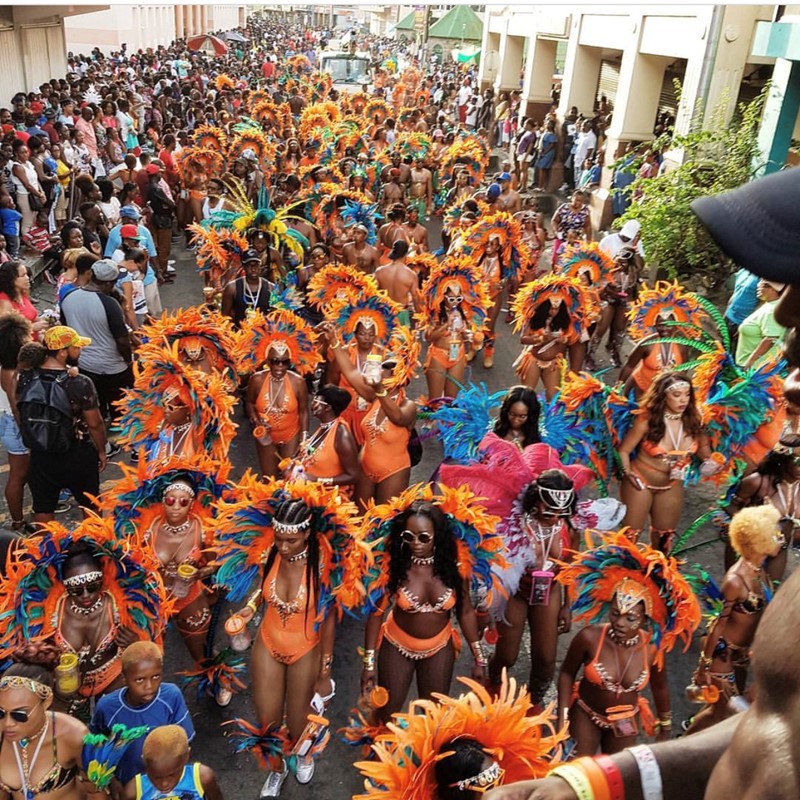
Excitement arrives at the beautiful destination of Antigua and Barbuda in late July with this year’s hotly anticipated Carnival, boasting plenty of music and ‘Mas’. Mas, short for masquerade, is a much-loved tradition that gives everyone a chance to show off their creativity by fashioning traditional Carnival costumes while parading and dancing to their choice of music. As Carnival officially begins, the lively sounds of calypso, steelpans and soca mingle with the laughter and cheers of locals and visitors alike.
The history of Carnival dates back to the island-wide celebrations on August 1st, 1834 when slavery was abolished. It wasn’t until 1957 that Antigua had its first official carnival celebration. Since then, the festival has grown and evolved into 13 joyous days of music, dance and revelry, complete with street marches, “jump-ups” and formal evening shows.
Carnival is perhaps the best time for visitors to plan their getaway to Antigua, to get a real insight into the culture and to understand and share the joy felt by Antiguans. Read on below for a taste of why Carnival’s reputation as “The Caribbean’s Greatest Summer Festival” is well-deserved, indeed!
The Sound of a Party
The Caribbean’s traditional music is an integral part of Antigua’s Carnival, and there are more than a few distinct varieties to dance the night away to. Calypso is one of the oldest musical styles in the Caribbean. It began as a way for enslaved people, who were forbidden to speak in the fields, to communicate with each other through music. It is a blend of the different dialects spoken in the region, with improvisational forms that depend largely upon the skill of the soloist (or ‘calypsonian’), who weaves the sounds of many cultures into a lyrical whole. Calypso competitions have always been a highlight of the Antigua Carnival.
Steelpan music was created in the early 1900s when cast-off oil drums from Trinidad’s burgeoning oil industry were recycled as musical instruments. Until then, bamboo percussion instruments had been used to accompany indigenous songs, with roots going back to the famous talking drums of West African cultures. As the popularity of the iron bands grew around the Caribbean, the people of Antigua and Barbuda took to the instruments with particular enthusiasm. Today, the islands are home to many of the Caribbean's finest steel bands.
Soca, an abbreviation of the soul of calypso, was created by a Trinidadian singer as an antidote to the influence of Jamaican reggae, which was replacing calypso with the younger generation. It blends calypso with soul and funk from the United States and East Indian rhythms. From its beginnings in Trinidad in the 1970s, by the middle of the 1980s, it had become an integral feature of the Antigua Carnival.
Parades and Pageantry
On opening day, the streets of the capital Saint John’s are filled with colourful costumes, beauty pageants, talent shows and enough music for everyone. The Recreation Ground is renamed Carnival City. It is the destination for the parades which wend their way around town accompanied by troupes of wildly costumed dancers, extravagant floats and their multitude of bands and supporters wearing not much more than paint and T-Shirts.
The first and second days of August are public holidays in Antigua when nearly two weeks of Carnival celebrations conclude in spectacular fashion. J'ouvert is celebrated on the first day of August. The term is derived from the Creole word for daybreak when the party is always in full swing. Emancipation Day marks the date in 1834 when slavery was abolished on the island. It is said that every Antiguan and Barbudan ran out into the streets to celebrate their newfound freedom and the tradition continues to this day.
The festivities include the Party Monarch and Calypso Monarch competitions of calypsonians, where entertainers who compose and sing calypsos vie to show off their best. The Panorama steel band competition brings together some of the best in the Caribbean. The spectacular Parade of Bands melds all styles of music with the addition of brass bands for a joyous parade in which all can participate. The most beautiful ladies in the islands come out for the Miss Antigua Pageant and the Caribbean Queens Competition. In addition to these major proceedings, the nonstop revelry of the Carnival includes countless smaller festivities, including local concerts, food fairs, parades and cultural shows.
A Celebration for Everyone
There’s something for every age at the Carnival, where the culture, history, and artistry of Antigua and Barbuda are on full, joyous display. Here’s the full calendar of events for 2023:
- Saturday, July 22 – Mr. and Miss Teenage Pageant
- Sunday, July 23 – Queen of Carnival
- Thursday, July 27 – Official Opening
- Friday, July 28 – Youth Rave
- Saturday, July 29 – T-Shirt Mas
- Sunday, July 30 – Junior Carnival and Junior Calypso
- Monday, July 31 – Jaycees Queen Show
- Tuesday, August 1 – Drue’s Day and Emancipation Watch Night
- Wednesday, August 2 – Junior Party Monarch
- Thursday, August 3 – Caribbean Melting Pot
- Friday, August 4 – Calypso Monarch
- Saturday, August 5 – Panorama
- Sunday, August 6 – Party Monarch
- Monday, August 7 – J’ouvert and Carnival Monday
- Tuesday, August 8 – Parade of the Bands and Last Lap


